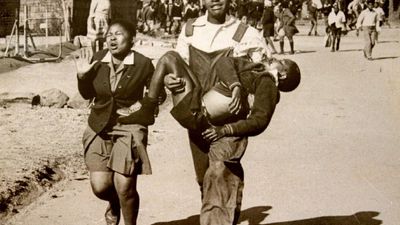Remembering Sam Nzima, The Photographer Who Exposed The Ills of Apartheid to The World
Sam Nzima, who died on Saturday, took one of the most famous photos of apartheid in South Africa.
Legendary South African photographer Sam Nzima died on Saturday at the age of 83. Nzima is behind one of the most famous photographs in South Africa, the one of young Hector Pieterson being carried by a fellow schoolmate, Mbuyisa Makhubu, after he got shot at by apartheid police in Soweto on June 16, 1976. Pieterson's sister Antoinette Sithole can be seen running alongside the young man carrying his brother.
Nzima took the image during the event that's now known as The June 16 Soweto Youth Uprising. He was covering the protest for The World, the newspaper he worked for.
"They were all happy. They were carrying placards, not guns," Nizma told the Mail & Guardian in 2016. The students were protesting Afrikaans being made the compulsory language of instruction in South African schools.
#SamNzima recounts how he took the iconic photo of a dying Hector Peterson on June 16, 1976. Video from @TIME via @NathiMthethwaSA. #RIPSamNzimapic.twitter.com/izew1n8jJ8
— Mail & Guardian (@mailandguardian) 13 May 2018
Nzima is said to have snapped six shots on his film camera, a Pentax SL, which he had kept until his time of passing, and was considering auctioning sometime to raise funds for opening a museum at his home in Mpumalanga. After taking the photos, he hid the film in his sock. The image would make the front page of The World, the next morning, and get published in some British newspapers.
Nzima was then wanted by the apartheid police after the government accused him of portraying the country in bad light.
He was forced to flee from Soweto where he lived with his family to his hometown of Lillydale. The World was soon shut down and Nzima's photojournalism career came to an end. The image led to sanctions being enforced on South Africa.
This is the camera that took the iconic Hector Pieterson picture. Former American First Lady Hilary Clinton wanted to buy it & take it to USA, but Mama Winnie instructed #SamNzima to keep the camera & not sell it to anyone.#RIPSamNzimapic.twitter.com/RjEoKN54aK
— Hloni Nyetanyane (@HloniNyetanyane) 13 May 2018
The photo has been widely used. But Nzima only recovered rights to it only in 1998 after a long copyright battle, but enforcing the rights was a tough task. As a result, he didn't gain much financially from one of the most famous and most used photographs in South Africa and the world.
Rest in Peace Ntate #SamNzima , you played pivotal role in our struggle. They wanted to buy your camera "West" and refused.
We dip our revolutionary banners pic.twitter.com/mxi8UAFWHF
— PAC OF AZANIA - POQO (@PACAZANIA59) 12 May 2018
Prior to his death, Nzima was running a school of photography in Bucksbridge in the Mpumalanga province.
The photographer was bitter for not being recognized enough by the government for the image. He is one of many other black South Africans who fought during the struggle against apartheid, but don't have much to show for it even after the ANC took power in 1994. Pilfering of images of the struggle taken by black photographers is an ongoing ill that mostly goes unpunished.
Nzima did however get some recognition. He is a recipient of the highest arts award in South Africa, The Order of Ikhamanga. He was given a bronze price for his photojournalism shining the international spotlight on apartheid.
The ANC did release a statement after Nzima's death was announced:
Spokesperson Pule Mabe said: "It is this photo that forced the world to come to terms with the brutality of and evils of apartheid system. It came at a price as Nzima was subjected to countless acts of intimidation and harassment by the cowardly security police who kept him under constant surveillance."
The Presidency's statement:
"It was through his lenses that South Africa saw he brutality and oppression suffered by its people under apartheid. The president sends his condolences to the Nzima family and wishes them strength during this difficult time."
President Cyril Ramaphosa's message:
"Mr Sam Nzima was one of a kind‚ his camera captured the full brutality of apartheid oppression on the nation's psyche and history from the Defiance Campaign through to forced removals and the Soweto student uprisings.
"We will especially remember his iconic photograph of a dying young Hector Pieterson which became a symbol of resistance against the imposition of Afrikaans as a medium of instruction in the black schools‚"
Tributes are still pouring in for the photographer who blew a whistle to the world about the ills of apartheid.
Salute to those that risked so much to bring us the truth... Hamba Kahle, #SamNzimapic.twitter.com/8CmA4fURBf
— Nickolaus Bauer (@NickolausBauer) 13 May 2018
May Your Soul Rest In Power Kokwana #SamNzima. This is a huge loss to the community of Bushbuckridge and the entire Nation . 🇿🇦 pic.twitter.com/9TFZzjiEqN
— •MABHARHULE• (@AmistoKhoza) 13 May 2018
#SamNzima The last click of liberation struggle cameraman is no more . Rest in Powerful peace and rise in glory... pic.twitter.com/EEAG48iW8T
— Godrich Gardee (@GardeeGodrich) 12 May 2018
The story behind the 16th June 1976 Soweto Uprising iconic picture taken by Sam Nzima#SamNzima#RIPSamNzimapic.twitter.com/jOBJtaQrtw
— #IAmWinnieMandela 🇿🇦 (@KatlehoMK) 13 May 2018
